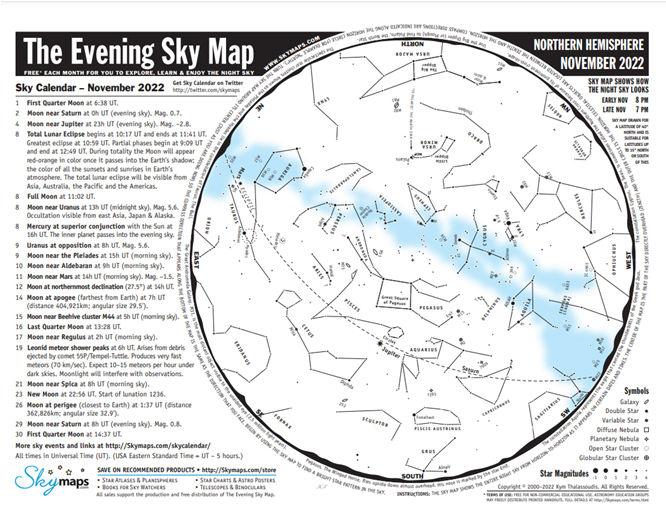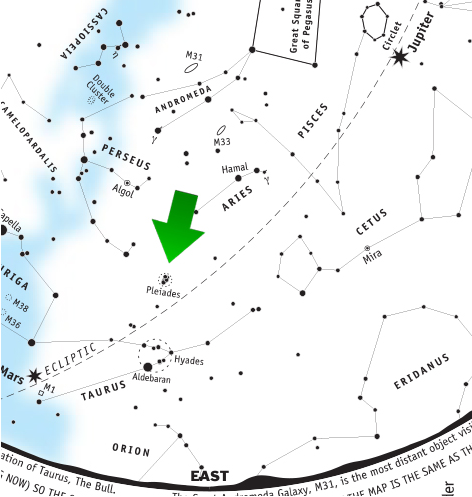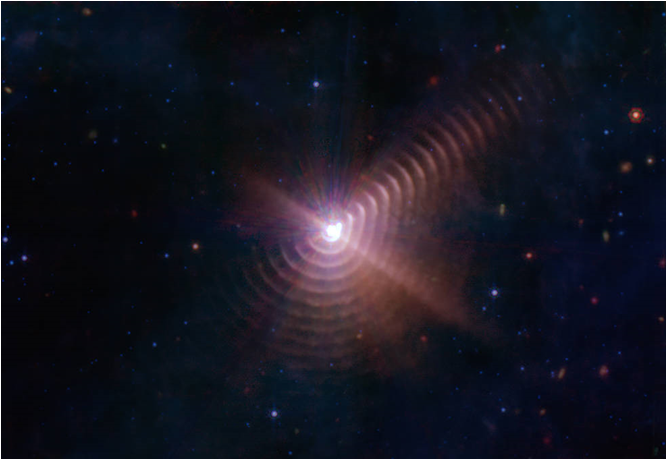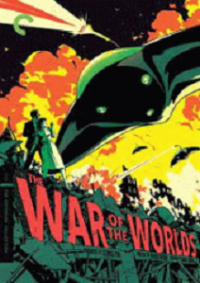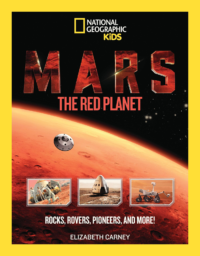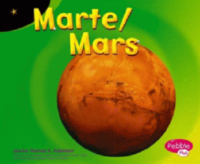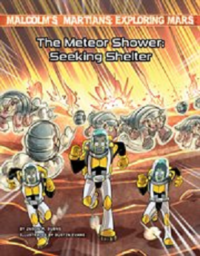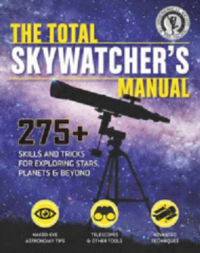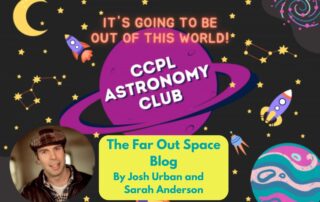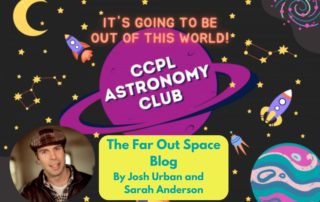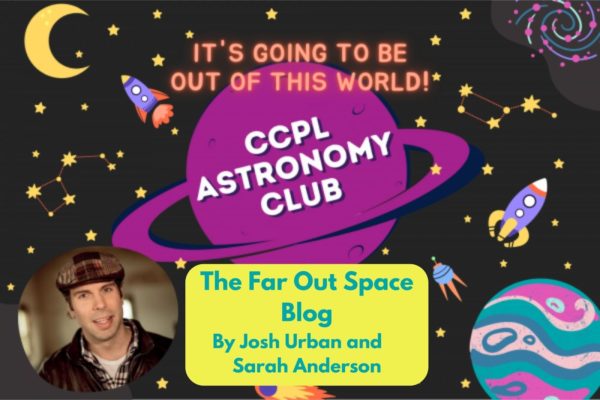
Ahoy, astronomers! Josh Urban here – host of the monthly CCPL Astronomy Club. Ready to recap, observe some cool fall sights, and watch the Leonid meteor shower? Welcome back to The Far Out Space Blog!
Previously on the CCPL Astronomy Club
The October meeting was great fun, with a ton of questions, and talk about the upcoming sky events (the Lunar eclipse on the 8th, and the Leonid meteor shower on the 17th-18th.) We also learned about one of the latest images from the James Webb Space Telescope. Was it aliens? No, just the dance of a double star system, compressing “space dust” into a strange and beautiful structure.
Any good adventure starts with a map, so here’s the November sky chart.
Sky Happenings & How To See Them
- Mars rises at 9 pm (and earlier as the month goes on.) Look for the bright orange-red planet in the east. You’ll notice it’s the brightest thing in the neighborhood, and it doesn’t twinkle, shining like a red space eye. It’s in the constellation Taurus. Note the reddish star Aldebaran nearby, and neighboring Capella, glittering orange-white in constellation Auriga, the Charioteer.
If you like scary science fiction and Mars, swing by your local library branch and check out the classic War of the Worlds by HG Wells. This book was written in the late 1800’s. That may seem long ago, but the Red Planet (Mars) has been fascinating people for thousands of years. Swing by the library and ask Ms. Sarah or one of her colleagues to borrow War of the Worlds.
- The Pleiades star cluster is a beautiful autumn sight, especially with binoculars. Check out this star cluster in the constellation of Taurus. Some people say it looks like a kite, and often mistake it for the little dipper. It’s also called “The Seven Sisters”, or more scientifically, Messier 45 (or M45.) Head outside after dark, find Jupiter blazing high in the southeast, and look lower, and to the left. (East.) If you’re not using binoculars, they’ll look like a small fuzzy glimmer of light. Scanning with binoculars, see how many stars you can count. It’s a whole bunch – the cluster contains over a thousand stars, and is 443 light years away. If we had a giant space highway, and could drive a car there at 60 miles an hour, it would take us about 4.5 billion years to get there. “Are we there yet?” “NO!”
- The Leonid meteor shower peaks overnight on November 17-18. While not forecast to be a storm this year, it’s worth getting outside for a look! The best time to watch is from after midnight to just before dawn – IF the sky is clear, of course. Face east, towards the constellation of Leo the Lion. He should be prowling up into the sky, looking like a backwards question mark. This is the radiant of the meteor shower, with the “shooting stars” appearing to radiate from this point of the sky. (But remember, the stars are way far away. Meteors happen when tiny grains of comet dust slam into the upper atmosphere of the Earth. The Leonid meteors are from Comet Temple-Tuttle!) Bundle up, sit in a comfortable chair, and see if you can spy any shooting stars. Be patient, and enjoy the stars while you’re waiting.
Webb’s Strange Discovery – What the heck is that? The James Webb Space Telescope (JWST) spied a strange sight, over 5,000 light years away. What could it be? Turns out that it’s a system of two massive stars, called Wolf-Rayet 140. (Worst band name ever!) As they dance around each other, this pattern is built.
From NASA: Each ring was created when the two stars came close together and their stellar winds (streams of gas they blow into space) met, compressing the gas and forming dust. The stars’ orbits bring them together about once every eight years; like the growth of rings of a tree’s trunk, the dust loops mark the passage of time.
We’re looking at over a century’s worth of dust here. Pass the space mop, and keep an eye on the JWST website for the latest findings!
Until Next Time – Get out under those stars, and see what you can find! Can you spot Jupiter, Saturn, and Mars? How about the moon? What phase is it in when you observe it? Even if you can’t find any of these, enjoy the looking. It sure is fun. I’ll see you in a few weeks. Let’s compare notes to see how many Leonid meteors we can spot! And check out Ms. Sarah’s book recommendations below. They’re groovy!
Clear skies!
– Josh
CCPL Astronomy Club is held on the last Thursday of every month, September through May except for November.
Register today to join us next time on November 17th at 6pm!
In the meantime check out some of these awesome books you can get from the library as well as some other great resources to learn more about this month’s topics!
The War of the Worlds by H.G. Wells, adapted by Malvina G. Vogel
As life on Mars becomes impossible, Martians and their terrifying machines invade the earth.
The War of the Worlds (Graphic Novel) by H.G. Wells, retold by Davis Worth Miller and Katherine McLean Brevard
Mars: The Red Planet by Elizabeth Carney (EBOOK)
To read this and many other National Geographic Kids ebooks just click on the section of the catalog listing where it says “Web Site: – Cengage” then enter your library card number and enjoy!

